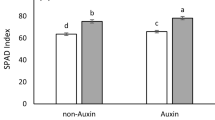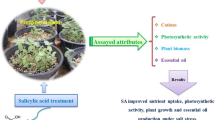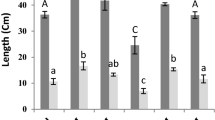Abstract
This study examined the influence of salt treatment on the growth parameters (fresh and dry weights), the mineral content (K+ and Na+), total lipid contents, fatty acid composition, yields and chemical composition of the essential oil of safflower (Carthamus tinctorius L.) grown in hydroponics for 2 weeks. Results showed that the application of 50 mM NaCl reduced the fresh weight of aerial parts (shoots and leaves) while it enhanced those of the roots. The reduction of dry weight was found to be more pronounced in the aerial parts. Salt treatment increased markedly the concentrations of Na+ in both plant parts while it reduced those of K+ which resulted in a sharp reduction of K+/Na+ ratio. In response to salt treatment, total lipids contents decreased in both plant parts and great qualitative changes in the fatty acids profiles were observed. Whatever the plant parts analysed, a redirection of the lipidic metabolism towards synthesis of unsaturated fatty acids as revealed by the increase of double bond index and linoleic desaturation ratio was pointed out. The increased unsaturation index was found to be more important in roots than in aerial parts. Such treatment also reduced the essential oil yields and induced marked quantitative changes in the chemical composition of the essential oils from both plant parts. Of all the identified components, oxygenated components display a prominent salt-induced synthesis and/or accumulation in both roots and aerial parts.

Similar content being viewed by others
References
Adams R (2001) Identification of essential oil components by gas chromatography/quadrupole mass spectroscopy. Allured, Carol Stream
Alam SM (1999) Nutrient uptake by plants under stress conditions. In: Pessarakli M (ed) Handbook of plant and crop stress. Marcel Dekker. New York, pp 285–313
Ashraf M, Harris PGC (2004) Potential biochemical indicators of salinity tolerance in plants. Plant Sci 166:3–16. doi:10.1016/j.plantsci.2003.10.024
Ashrafi E, Razmjoo K ((2010)) Effect of irrigation regimes on oil content and composition of Safflower (Carthamus tinctorius L.) cultivars. J Am Oil Chem Soc 87:499–506. doi:10.1007/s11746-009-1527-8
Baatour O, Kaddour R, Aidi Wannes W, Lachaâl M, Marzouk B (2010) Salt effects on the growth, mineral nutrition, essential oil yield and composition of marjoram (Origanum majorana). Acta Physiol Plant 32:45–51. doi:10.1007/s11738-009-0374-4
Bassil ES, Kaffka SR (2002) Response of safflower (Carthamus tinctorius L.) to saline soils and irrigation I. Consumptive water use. Agr Water Manage 54:67–80
Ben Taârit M, Msaada K, Hosni K, Marzouk B (2010) Changes in fatty acid and essential oil composition of sage (Salvia officinalis L.) leaves under NaCl stress. Food Chem 119:951–956. doi:10.1016/j.foodchem.2009.07.055
Ben Taârit M, Msaada K, Hosni K, Marzouk B (2011) Physiological changes and essential oil composition of clary sage (Salvia sclarea L.) rosette leaves as affected by salinity. Acta Physiol Plant 33:153–162. doi:10.1007/s11738-010-0532-8
Bligh EG, Dyer WJ (1959) A rapid method of total lipid extraction and purification. Can J Biochem Physiol 37:911–917
Bourgou S, Bettaieb I, Saidani M, Marzouk B (2010) Fatty acids, essential oil and phenolics modifications of black cumin fruit under NaCl stress conditions. J Agric Food Chem 58:12399–12406. doi:10.1021/jf103415q
Bowles VG, Mayerhofer R, Davis C, Good AG, Hall JC (2010) A phylogenetic investigation of Carthamus combining sequence and microsatellite data. Plant Syst Evol 287:85–97. doi:10.1007/s00606-010-0292-3
Brady CJ, Gibson TS, Barlow EWR, Speirs J, WynJones RG (1984) Salt tolerance in plants. I. Ions compatible organic solutes and the stability of plant ribosomes. Plant Cell Environ 7:571–578
Cecchi G, Biasini S, Castano J (1985) M′ethanolyse rapide des huiles en solvents. Note de laboratoire. Rev Franc Corps Gras 4:163–164
Chartzoulakis A, Patakas A, Kofidis G, Bosabalidis A, Nastou A (2002) Water stress affects leaf anatomy, gas exchange, water relations and growth of two avocado cultivars. Sci Hortic 95:39–50
Çiçek N, Çakirlar H (2008) Effects of salt stress on some physiological and photosynthetic parameters at three different temperatures in six soya Bean (Glycine max LMerr.) cultivars. J Agric Crop Sci 194:34–46. doi:10.1111/j.1439-037X.2007.00288.x
Croteau R (1987) Biosynthesis and catabolism of monoterpenoids. Chem Rev 87:929–954
da Silva EC, Nogueira RJMC, Araujo FP, Melo NF, de Azevedo Neto AD (2008) Physiological responses to salt stress in young umbu plants. Environ Exp Bot 63:147–157. doi:10.1016/j.envexpbot.2007.11.010
Dajue L, Mandel H–H (1996) Safflower, Carthamus tinctorius L. In: Promoting the conservation and use of underutilized and neglected crops, vol 7. Institute of Plant Genetics and Crop Plant Research. Gatersleben/International Plant Genetic Resources Institute, Rome
Daneshmand F, Arvin MJ, Kalantari KM (2010) Physiological responses to NaCl stress in three wild species of potato in vitro. Acta Physiol Plant 32:91–101. doi:10.1007/s11738-009-0384-2
De Lacerda CF, Cambraia J, Oliva MA, Ruiz HA (2005) Changes in growth and in solute concentrations in sorghum leaves and roots during salt stress recovery. Environ Exp Bot 54:69–76
Gadallah MAA (1996) Abscisic acid, temperature and salinity interactions on growth and some mineral elements in Carthamus plants. Plant Growth Regul 20:225–236
Gao WY, Fan L, Paek KY (2000) Yellow and red pigment production by cell cultures of Carthamus tinctorius in a bioreactor. Plant Cell Tissue Organ Culture 60:95–100
Gecgel U, Demirci M, Esendal E, Tasan M (2007) Fatty acid composition of the oil from developing seeds of different varieties of safflower (Carthamus tinctorius L.). J Am Oil Chem Soc 84:47–54. doi:10.1007/s11746-006-1007-3
Gignon A, Matos A-R, Aferay D, Zuily-Fodil Y, Pham-Thi A-T (2004) Effect of drought stress on lipid metabolism in the leaves of Arabidopsis thaliana (Ecotype Columbia). Ann Bot 94:345–351. doi:10.1093/aob/mch150
Gill SS, Tuteja N (2010) Reactive oxygen species and antioxidant machinery in abiotic stress tolerance in crop plants. Plant Physiol Biochem 48:909–930. doi:10.1016/j.plaphy.2010.08.016
Hiramatsu M, Takahashi T, Komatsu M, Kido T, Kasahara Y (2009) Antioxidant and neuroprotective activities of mogami-benibana (Safflower, Carthamus tinctorius Linne). Neurochem Res 34:795–805. doi:10.1007/s11064-008-9884-5
Hoagland DR, Arnon DI (1950) The water culture method for growing plants without soil. Circ 347. Calif Agric Exp Sta Berkley, CA, p 32
Irving DW, Shannon MC, Breda VA, Mackey BE (1998) Salinity effects on yield and oil quality of high linolate and high-oleate cultivars of Safflower (Carthamus tinctorius L). J Agric Food Chem 36:37–42
Karray-Bouraoui N, Harbaoui F, Rabhi M, Jallali I, Ksouri R, Attia H, Msilini N, Lachaâl M (2011) Different antioxidant responses to salt stress in two different provenances of Carthamus tinctorius L. Acta Physiol Plant. doi:10.1007/s11738-010-0679-3
Khadhri A, Neffati M, Smiti S, Nogueira JMF, Araújo MEM (2011) Influence of salt stress on essential oil yield and composition of lemon grass (Cymbopogon schoenanthus L. Spreng. ssp. Laniger (Hook) Maire et Weil). Nat Prod Res 25:108–117. doi:10.1080/14786419.2010.505169
Kim H-Y, Kim C–S, Jhon G-J, Moon I–S, Choi S–H, Cho K–S, Chai J-K, Kim C–K (2002) The effect of safflower seed extract on periodontal healing of 1-wall intrabony defects in beagle dogs. J Periodontol 73:1457–1466
Lee JY, Chang EJ, Kim HJ, Park JH, Choi SW (2002) Antioxidative flavonoids from leaves of Carthamus tinctorius. Arch Pharm Res 25:313–319
Li R, Shi F, Fukuda K (2010) Interactive effects of various salt and alkali stresses on growth organic solutes, and cation accumulation in a halophyte Spartina alterniflora (Poaceae). Env Exp Bot 68:66–74. doi:10.1016/j.envexpbot.2009.10.004
López-Pérez L, MdC Martínez-Ballesta, Maurel C, Carvajal M (2009) Changes in plasma membrane lipids, aquaporins and proton pump of broccoli roots, as an adaptation mechanism to salinity. Phytochemistry 70:492–500. doi:10.1016/j.phytochem.2009.01.014
Malkit A, Sadka A, Fisher M, Goldshlag P, Gokhman I, Zamir A (2002) Salt induction of fatty acid elongase and membrane lipid modifications in the extreme halotolerant Alga Dunaliella salina. Plant Physiol 129:1320–1329
Matsui K (2006) Green leaf volatiles: hydroperoxide lyase pathway of oxylipin metabolism. Curr Opin Plant Biol 9:274–280. doi:10.1016/j.pbi.2006.03.002
Mondal N, Bhat KV, Srivastava PS (2010) Variation in fatty acid composition in Indian germplasm of sesame. J Am Oil Chem Soc 87:1263–1269. doi:10.1007/s11746-010-1615-9
Naffati M, Marzouk B (2008) Changes in essential oil and fatty acid composition in coriander (Coriandrum sativum L.) leaves under saline conditions. Ind Crops Prod 28:137–142. doi:10.1016/j.indcrop.2008.02.005
Nogala-Kalucka M, Rudzinska M, Zadernowski R, Siger A, Krzyzostaniak I (2010) Phytochemical content and antioxidant properties of deeds of unconventional oil Plants. J Am Oil Chem Soc 87:1481–1487. doi:10.1007/s11746-010-1640-8
Novruzov E, Shamsizade L (1998) Anthocyans of Carthamus species. Chem Nat Comp 34:514–515
Parida AK, Das AB (2005) Salt tolerance and salinity effects on plants: a review. Ecotoxicol Environ Saf 60:324–349. doi:10.1016/j.ecoenv.2004.06.010
Pleines S, Friedt W (1988) Breeding for improved C18-fatty acid composition in rapeseed (Brassica napus L.). Fat Sci Technol 90:167–171
Rammal H, Younos C, Bouayed J, Chakou A, Necerbey N, Soulimani R (2009) Aperçu ethnobotanique et phytopharmacologique sur Carthamus tinctorius L. Phytothérapie 7:28–30. doi:10.1007/s10298-008-0361-8
Sehgal D, Raina SN, Devarumatha RM, Sasanuma T, Sasakuma T (2009) Nuclear DNA assay in solving issues related to ancestry of the domesticated diploid safflower (Carthamus tinctorius L.) and the polyploid (Carthamus) taxa, and phylogenetic and genomic relationships in the genus Carthamus L. (Asteraceae). Mol Phylogenet Evol 53:631–644
Singh-Sangwan N, Farooqi AHA, Sangwan RS (2004) Effect of drought stress on growth and essential oil metabolism in lemongrasses. New Phytol 128:173–179
Stumpf PK (1975) Recent advances in the chemistry and biochemistry of’plant lipids. In: Galhard T, Mercer MI (eds) Academic Press, London, p 95.
Viégas RA, Queiroz JE, Silva LMM, Silveira JAG, Rocha IMA, Viégas PRA (2003) Plant growth, accumulation and solute partitioning of four forest species under salt stress. Rev Bras Eng Agric Amb 7:258–262
Yu Y, Yang B, Zhou T, Zhang H, Shao L, Duan G (2007) Rapid determination of volatile constituents in safflower by microwave distillation and simultaneous solid-phase microextraction coupled with gas chromatography-mass spectrometry. Ann Chim 97:1075–1084
Acknowledgments
The authors wish to thank Asma Allaoui (Laboratoire des Sciences de l’Environnement, Ecole Nationale d’Ingénieurs de Sfax, Tunisia) for the GC–MS analysis.
Author information
Authors and Affiliations
Corresponding author
Additional information
Communicated by W. Filek.
Rights and permissions
About this article
Cite this article
Harrathi, J., Hosni, K., Karray-Bouraoui, N. et al. Effect of salt stress on growth, fatty acids and essential oils in safflower (Carthamus tinctorius L.). Acta Physiol Plant 34, 129–137 (2012). https://doi.org/10.1007/s11738-011-0811-z
Received:
Revised:
Accepted:
Published:
Issue Date:
DOI: https://doi.org/10.1007/s11738-011-0811-z




